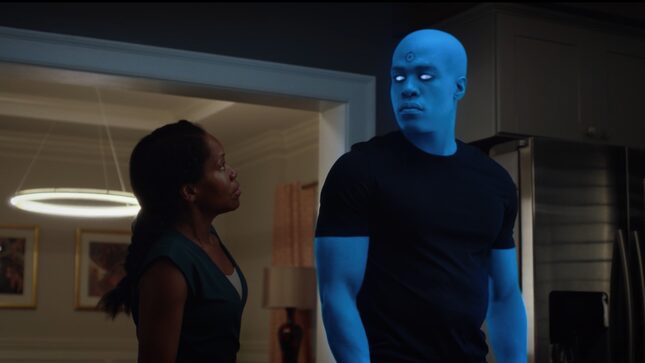

This review contains spoilers.
HBO’s Watchmen spent nine episodes of its first—and perhaps only—season meticulously building the terrors of white supremacy into the backbone of its story. This is a show that kicked off with a graphic retelling of the 1921 Tulsa race riot; it showed viewers where it stood from the jump, before segueing into the double life of retired cop and masked vigilante Angela Abar (Regina King), who’s helping the Tulsa police force to crack down on a group of white supremacist terrorists called the Seventh Kalvary. Twists and turns (and nutty B-plots featuring an absolutely wild Jeremy Irons as Adrian Veidt, aka. Ozymandias) ensued, many of which made it hard to sit through a single episode without uttering, “Wait, what the fuck?” at least twice. Nonetheless, the show’s politics drew praise, while racists petulantly review-bombed the show en masse.
One of the biggest twists came at the end of Episode 7 when viewers discovered that Angela’s unassuming husband, Cal Abar (Yahya Abdul-Mateen II), is actually Jon Osterman, aka. Dr. Manhattan. Ten years prior, when Dr. Manhattan first met Angela, he mimicked the form of a miscellaneous cadaver of Angela’s choosing so he could look a lot less blue and a lot more human. They also figured out a way to alter his memory so that his past—his childhood as a German refugee during WWII, his career as a physicist and lab accident that turned him into the blue, godlike being he is in the first place, etc.—could be blocked. But when an emergency in the present day caused Angela to unceremoniously reverse the block (in the form of a hammer and a few good whacks to Cal’s head), Jon’s blue form emerged, while his physical traits were still Cal’s.
In other words, Dr. Manhattan—Jon Osterman—looked black. Perhaps 10 years of taking on the form of a random black guy will do that to a telekinetic, clairvoyant, godlike being. That was essentially the show’s throwaway reason for it, at least. I, for one, am not complaining that we got to see Abdul-Mateen master Dr. Manhattan’s signature monotone. And I’m certainly not opposed to seeing him walking around with his immaculate dick and Adonis-like bottom on full display for large swaths of Episode 8. Regarding Dr. Manhattan’s blackness, Abdul-Mateen told The Atlantic, “In a world where white supremacy is the antagonist of our story, it makes sense that a god is inhabited by a black man.” It’s hard to argue against this, and it proves that this casting wasn’t just a cynical representation grab bag.

But a major plot point of Episodes 8 and 9 was Dr. Manhattan’s capture by the Kalvary, also known as Cyclops, which is best described as a branch of the Ku Klux Klan, which has long dabbled in mind control. Cyclops hoped to extract Dr. Manhattan of his powers and transfer them to Senator Keene, a young, charismatic—and deeply racist—politician who would use those powers for Cyclops’s own version of making America great again. Keene turned into literal goo in his attempt (“Absorbing atomic energy without filtering it first is going to pop you like a water balloon every time,” as Lady Trieu said), but I was struck by something else first. Once Keene was able to capture Dr. Manhattan and gleefully paraded him before the upper echelon of Cyclops, no one was taken aback by the fact that the godlike being before them looked like the very people their organization terrorized.
He was blue, but he was black.
Dr. Manhattan was literally blue, but the physical features were unmistakable. The man was black. He was blue, but he was black. Surely, he was tainted now, or at least a minor disappointment. So I watched with bated breath, waiting for one of the white supremacists to squint in Dr. Manhattan’s direction, to whisper to one of their comrades, to ask themselves if this man that America has canonized for generations has always looked like a black guy, and they just never noticed until now. At the very least, I wondered if Laurie Blake—Manhattan’s old flame from way back when—was confused by his appearance upon seeing him for the first time in what must have been decades.
This did not happen. God is black, and nobody batted an eye.
In fact, the only time that there has been any mention of Dr. Manhattan’s blackness was in Episode 8, when Veidt sees Dr. Manhattan in his new black form and quips, “It’s not the ’80s anymore, Jon. This kind of appropriation is considered quite problematic now.”
Dr. Manhattan is no longer human and does not grasp the significance of race and identity, but the people around him still do. So it seemed strange that some of the people who would care the most—a secret group of white supremacists who have literally been planning a race war—were utterly unbothered by the blue-black man before them.
It wouldn’t have necessarily been better if the Cyclops members were repulsed or perplexed by Dr. Manhattan’s appearance, by his wide nose and thick lips. Their reaction didn’t have to mimic the Chapelle’s Show sketch when blind KKK leader Clayton Bigsby (played by Dave Chapelle) takes off his hood and inadvertently reveals that he’s a black man, causing at least one of his followers’ heads to explode while another throws up in disgust. (They all got vaporized anyway, it’s fine.) But it struck me that in the same scene where Keene calls Angela a “black bitch,” he seems completely nonplussed by the manifestation of blackness in Dr. Manhattan’s new form.
Though this didn’t deter me from enjoying the episode, I struggled to suspend my disbelief that Dr. Manhattan’s blue skin alone could turn the most virulent racists completely “colorblind.” Cyclops’s lack of outrage about Dr. Manhattan’s blackness didn’t come across as an oversight, though; it felt deliberate, as if a point was trying to be made, although I’m not quite sure what it was.